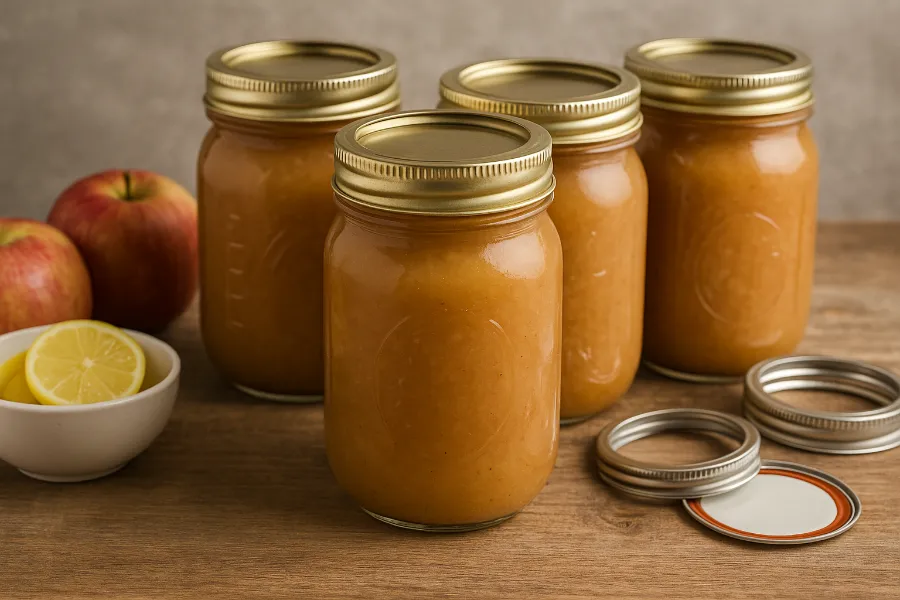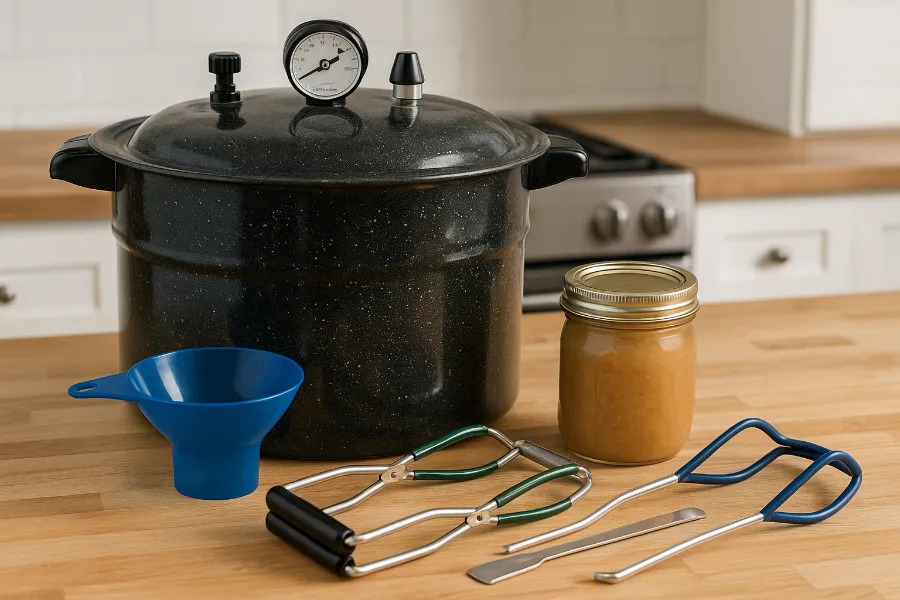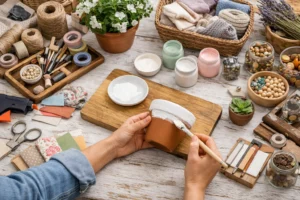Every fall, when my kitchen smells like cinnamon and crisp apples, I find myself going back to one of my favorite seasonal rituals making homemade applesauce. It’s comforting, simple, and deeply nostalgic. The kind of recipe that doesn’t just fill your jars, but also your soul.
Over the years, I’ve learned that the secret to perfect applesauce isn’t just about flavor it’s about preserving apples the right way so every jar tastes like a bite of autumn months later. This is my complete guide to making, canning, and storing applesauce safely, with all the lessons I’ve learned along the way.
Preserving Apples

If you’ve ever found yourself staring at a counter overflowing with apples from a local orchard, you’ve probably asked: What can I do with all of these before they spoil? For me, the answer has always been preserving apples.
Making applesauce is the most forgiving and rewarding way to preserve them. You don’t need fancy tools—just a big pot, clean jars, and some patience. Unlike pies or dehydrating, applesauce can be stored for months, freeing your freezer space and letting you enjoy your harvest deep into winter.
Preserving isn’t just about keeping food it’s about keeping traditions alive. My grandmother used to fill entire shelves with jars of golden sauce, and the sound of lids “pinging” as they sealed was our family’s version of a lullaby.
How to Keep Applesauce from Turning Brown
One of the first lessons I learned the hard way was how to keep applesauce from turning brown. When you’re slicing and simmering apples, oxidation starts fast, and before you know it, that bright yellow sauce turns dull.
Here’s what works every single time:
- Add lemon juice early. Use one tablespoon of bottled lemon juice for every pint of sauce. It’s not just about acidity—it keeps your applesauce fresh and golden.
- Cook soon after cutting. The longer your apples sit, the darker they’ll get.
- Don’t overcook. Gentle simmering keeps the flavor light and the color bright.
- Store properly. Airtight jars prevent oxygen from dulling the color.
Even with a hint of brown, your applesauce will still taste wonderful but when you follow these steps, it’ll also look just as good.
Sterilizing Jars
Let’s talk about the least glamorous but most important part of canning sterilizing jars. I can’t tell you how many new canners skip this step, only to find spoiled applesauce weeks later.
To sterilize properly:
- Wash your jars and lids in hot, soapy water.
- Place jars right-side up in your canner or a large stockpot.
- Cover with water and bring to a simmer for 10 minutes.
- Keep them hot until you’re ready to fill.
This simple step kills any lurking bacteria and makes sure your jar sealing works perfectly later. Think of it as the quiet prep work behind every successful batch.
Jar Sealing
Ah, jar sealing—that satisfying “ping” when your jars cool and vacuum seal. It’s music to every canner’s ears.
After you ladle hot applesauce into sterilized jars, wipe the rims clean (any residue can ruin your seal). Then, center the lid and screw the band on just fingertip tight—don’t overtighten.
Once processed, let the jars sit undisturbed for at least 12 hours. When you press the lid’s center, it should be firm, with no movement. That’s how you know your applesauce is safely sealed.
If a jar doesn’t seal? Don’t panic. Just refrigerate it and use it within a week. The rest of your jars—those beautiful, golden, shelf-stable ones—are your reward.
Apple Canning
When I first started apple canning, I was intimidated. The gear, the timing, the science—it all sounded complicated. But once you understand the basics, it becomes second nature.
Canning apples or applesauce isn’t about perfection; it’s about creating food that’s safe, nourishing, and made with love. I always recommend starting with applesauce before graduating to pie fillings or apple butter—it’s the easiest and most forgiving introduction to home canning.
Choose a blend of sweet and tart apples for balance, and always cook them down before filling your jars. Hot-packing (filling jars with warm applesauce) helps reduce air bubbles and ensures even processing during canning.
Applesauce
Let’s pause on the star of the show applesauce itself.
There’s something so simple and perfect about transforming a basket of apples into something you can spoon over pancakes, swirl into oatmeal, or just eat straight from the jar. I like mine smooth, with just a hint of cinnamon and a squeeze of lemon.
To make applesauce:
- Wash, peel, core, and chop your apples.
- Add them to a large pot with about ½ cup of water per 8 cups of apples.
- Simmer gently until soft, stirring often.
- Mash or blend to your desired texture.
At this stage, your house smells incredible—like sweet nostalgia.
Canning Applesauce
Now that you’ve made your applesauce, let’s move to canning applesauce—the part that turns your kitchen project into long-term pantry gold.
Hot-packing is key: reheat your applesauce until it’s steaming, then ladle it into hot jars, leaving ½ inch of headspace. Wipe rims, apply lids, and tighten bands fingertip tight.
Every detail matters here. Those little steps—sterilized jars, clean rims, proper headspace—are what keep your food safe. You’re not just making applesauce; you’re mastering a skill that families have relied on for generations.
Water Bath Canning
For canning applesauce, I prefer the water bath canning method. Apples are naturally acidic, which makes them ideal for this simple preservation technique.
Here’s how to do it right:
- Place filled jars in your canner with at least 1–2 inches of water above the lids.
- Bring to a full rolling boil.
- Process for 20 minutes (pints or quarts).
- Adjust time for altitude if needed.
- Let jars rest in the canner for 5 minutes before removing.
When you pull them out and hear that first “ping,” you’ll understand why so many of us fall in love with canning—it’s satisfaction in its purest form.
Food Preservation
Canning applesauce is about more than just saving food—it’s about food preservation in the truest sense. It connects us to the rhythm of the seasons. You take what’s abundant now and prepare it for when the trees are bare and the air is cold.
Homemade applesauce becomes your taste of summer in the middle of January. It’s proof that with a little knowledge and effort, you can keep your pantry stocked with wholesome, homemade food that didn’t come from a store shelf.
For anyone wanting to embrace a more sustainable kitchen, food preservation is an empowering skill it’s practical, frugal, and deeply fulfilling.
Pressure Canning

Although pressure canning isn’t necessary for applesauce (since apples are high-acid), I sometimes use it when I’m canning mixed fruit blends. If you’re confident with your canner, it’s a great skill to have in your back pocket.
Pressure canning works faster and reaches higher temperatures than a water bath, which can be helpful if you’re working with lower-acid ingredients.
For applesauce:
- Process jars at 6 lbs pressure for 8 minutes (dial gauge) or 10 lbs (weighted gauge).
- Adjust pressure for altitude as recommended in your canner’s guide.
But for most home cooks, water bath canning remains the easiest and most reliable method for applesauce.
How Long Does Canned Applesauce Last
So, you’ve got your jars cooling on the counter—now you’re wondering: how long does canned applesauce last?
If stored properly, canned applesauce can last up to 12 months. I’ve even opened jars that were perfectly fine after 18 months (though I don’t recommend stretching it that long for safety reasons).
Store jars in a cool, dark place—ideally between 50°F and 70°F. Keep them away from sunlight and temperature fluctuations.
Once opened, refrigerate your applesauce and use it within a week. If you notice any mold, discoloration, or lid bulging, discard it immediately. Food safety always comes first.
Troubleshooting Common Canning Issues
Every canner has a story or two about a batch that didn’t go as planned. Here’s what I’ve learned to look out for:
If your jar didn’t seal: Wipe rims better next time or replace old lids. You can reprocess the same day.
If your applesauce turned brown: You may have skipped the lemon juice or cooked too long.
If jars cracked: They may have been too cold when you added hot sauce. Keep jars hot until filling.
If applesauce is too thin: Let it simmer longer before canning.
Canning teaches patience. The more you do it, the more intuitive it becomes.

The Joy of Homemade Applesauce
After years of doing this, making homemade applesauce is one of those rituals I look forward to every fall. The chopping, the stirring, the sound of the jars sealing—it’s meditative in its own way.
Every jar on the shelf represents care, effort, and tradition. It’s the kind of work that reminds you that real food doesn’t have to be complicated. It just takes time and love.
So next time you find yourself with a basket of apples and a free afternoon, try making your own. You’ll not only fill your pantry but also your home with the scent of something truly timeless.
FAQs
A mix of sweet and tart apples like Fuji, Honeycrisp, and Granny Smith creates the best flavor. The combination gives you a balanced sweetness and a touch of tang.
Add one tablespoon of bottled lemon juice per pint of applesauce. It prevents oxidation and helps keep that golden, fresh look.
Yes, sterilizing jars is essential for safety. It removes bacteria and ensures a proper seal that keeps your applesauce shelf-stable.
In a water bath canner, process pint or quart jars for 20 minutes at sea level. Adjust for altitude by adding 5–15 minutes as needed.
You can, but it’s optional since apples are high-acid. If you use one, process at 6 lbs pressure for 8 minutes or 10 lbs if weighted.
Properly sealed jars can last up to 12 months in a cool, dark pantry. Once opened, refrigerate and use within a week.
It could be due to residue on the rim, an old lid, or overtightening the band. Reprocess unsealed jars within 24 hours using new lids.













